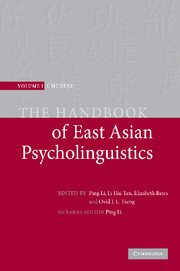Description
The Handbook of East Asian Psycholinguistics
The Handbook of East Asian Psycholinguistics 3 Volume Paperback Set Series
Coordinators: Li Ping, Tan Li Hai, Bates Elizabeth, Tzeng Ovid J. L.
This 2006 handbook presents a discussion of the psycholinguistic study of Chinese.
Language: English
Subject for The Handbook of East Asian Psycholinguistics:
The Handbook of East Asian Psycholinguistics
Publication date: 07-2012
Support: Print on demand
Publication date: 07-2012
Support: Print on demand
Handbook of east asian psycholinguistics, volume 1 chinese
Publication date: 04-2006
476 p. · 16.1x22.9 cm · Hardback
Publication date: 04-2006
476 p. · 16.1x22.9 cm · Hardback
Description
/li>Contents
/li>
A large body of knowledge has accumulated on the cognitive processes and brain mechanisms underlying language. Much of this knowledge has come from studies of Indo-European languages, in particular English. Chinese, spoken by one-fifth of the world's population, differs significantly from most Indo-European languages in its grammar, its lexicon, and its written and spoken forms - features which have profound implications for the learning, representation and processing of language. This handbook, first published in 2006 as the first in a three-volume set on East Asian psycholinguistics, presents a discussion of the psycholinguistic study of Chinese. With contributions by over fifty leading scholars, it covers topics in first- and second-language acquisition, language processing and reading, language disorders in children and adults, and the relationships between language, brain, culture, and cognition. It will be invaluable to all scholars and students interested in the Chinese language, as well as cognitive psychologists, linguists, and neuroscientists.
Part I. Language Acquisition: 1. Actions and results in the acquisition of Cantonese verbs Sik Lee Cheung and Eve V. Clark; 2. Chinese children's knowledge of binding principles Yu-Chin Chien and Barbara Lust; 3. Chinese classifiers: their use and acquisition Mary Erbaugh; 4. Child language acquisition of temporality in Mandarin Chinese Chiung-chih Huang; 5. Second language acquisition by native Chinese speakers Gisela Jia; 6. Making explicit children's implicit epilanguage in learning to read Chinese Che Kan Leong; 7. Emergent literacy skills in Chinese Catherine McBride-Chang and Yiping Zhong; 8. Basic syntactic categories in early language development Rushen Shi; 9. Growth of orthography-phonology knowledge in the Chinese writing system Hua Shu and Ningning Wu; 10. Interaction of biological and environmental factors in phonological learning Stephanie Stokes; 11. The importance of verbs in Chinese Twila Tardif; 12. Grammar acquisition via parameter setting Charles Yang; 13. Early bilingual acquisition in the Chinese context Virginia Yip; Part II. Language Processing: 14. Word form encoding in Chinese speech production Jenn-Yeu Chen and Gary S. Dell; 15. Effects of semantic radical consistency and combinability on the Chinese character processing May Jane Chen, Brendan S. Weekes, Danling Peng and Qin Lei; 16. Eye movement in Chinese reading: basic processes and cross-linguistic differences Gary Feng; 17. The Chinese character in psycholinguistic research: form, structure and the reader Douglas Honorof and Laurie Feldman; 18. Perception and production of Chinese tones Allard Jongman, Yue Wang, Corinne B. Moore and Joan A. Sereno; 19. Phonological mediation in visual word recognition in English and Chinese In-mao Liu, Jei-tun Wu, Iue-ruey Sue and Sau-chin Chen; 20. Reading Chinese characters: orthography, phonology, meaning and the textual constituency model Charles A. Perfetti and Ying Liu; 21. Processing of characters by native Chinese readers Marcus Taft; 22. L2 acquisition and the processing of Mandarin tones Yue Wang, Joan A. Sereno and Allard Jongman; 23. The comprehension of coreference in Chinese discourse Chin Lung Yang, Peter C. Gordon and Randall Hendrick; 24. Lexical ambiguity resolution in Chinese sentence processing Yaxu Zhang, Ningning Wu and Michael Yip; Part III. Language and the Brain: 25. The relationship between language and cognition Terry Kit-fong Au; 26. Language processing in bilinguals as revealed by functional imaging: a contemporary synthesis Michael W. L. Chee; 27. Specific language impairment in Chinese Paul Fletcher, Stephanie Stokes and Anita M.-Y. Wong; 28. Brain mapping of Chinese speech prosody Jackson T. Gandour; 29. Modelling language acquisition and representation in connectionist networks Ping Li; 30. The manifestation of aphasia syndromes in Chinese Jerome L. Packard; 31. Naming of Chinese phonograms: from cognitive science to cognitive neuroscience Dan-ling Peng and Hua Jiang; 32. How the brain reads the Chinese language: recent neuroimaging findings Li Hai Tan and Wai Ting Siok; Epilogue: a tribute to Elizabeth Bates.
© 2024 LAVOISIER S.A.S.




